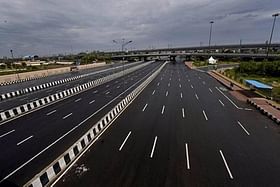The highway length constructed since 2014 till date can together potentially avoid 32.15 million tonnes of CO2 annually and 642.95 million tonnes of CO2 cumulatively in next 20 years, says the report.
The construction of National Highways (NHs) and greenfield expressways in the past nine years have the potential to avoid 3.21 crore tonnes of carbon dioxide (CO2) emission annually.
This was estimated in a new study done by the Central Road Research Institute (CRRI) and The Energy and Resources Institute (TERI).
The assessment has been done including both the construction period and operation phase of the NHs and expressways.
The estimated avoidance of the CO2 emission has been arrived at considering different factors, including how the new and improved NH, replacing congested and often circuitous routes, can help avoid the greenhouse gas emission by reducing fuel combustion in vehicles plying on them.
It has also included the impact of avenue plantations and compensatory afforestation.
The report titled “Assessment of Avoided CO2 Emissions during Construction and Operation of National Highways”, was released by Union Environment Minister Bhupender Yadav, on Wednesday (22 February).
The report said the year on year length of NHs constructed since 2014 stands at 77,265 km.
“Based on the CO2 avoided per km value estimated, it is concluded that the highway length constructed since 2014 till date can together potentially avoid 32.15 million tonnes of CO2 annually and 642.95 million tonnes of CO2 cumulatively in next 20 years. This is equivalent to CO2 sequestration by 36,149 million trees,” the report said.
The expert agencies collected data of 20 highway stretches — five greenfield and 15 brownfield stretches — including the Eastern Peripheral, Delhi-Meerut, Delhi-Dehradun and Ahmedabad-Vadodara expressways, Delhi-Agra, Panipat-Jalandhar and Pune-Solapur highways.
While greenfield highways are built on new alignments, the existing roads are widened under the brownfield category. Currently, most of the highway developments fall under the brownfield category.
According to the report, in the case of these 20 projects, it is estimated that the total fuel consumption would be about 41.2 billion litres in a 20-year period when these are operational.
“This amount of consumption is less by 19 per cent or 9.8 billion litres of fuel is saved in the improvement case as compared to the business as usual (BAU) case,” the report said.
It added that in the total fuel savings, the share of petrol will be about 7 per cent and the rest will be the share of diesel. The major savings will be 53 per cent and 23 per cent by medium and heavy commercial vehicles respectively.
It has also been estimated that in case of greenfield highways improvements, the CO2 avoidance in 20 years can be of the order of 10,167 tonnes per km.
Whereas in case of improvements of brownfield highways, it can result in about 11,936 tonnes per km of CO2 avoidance.


